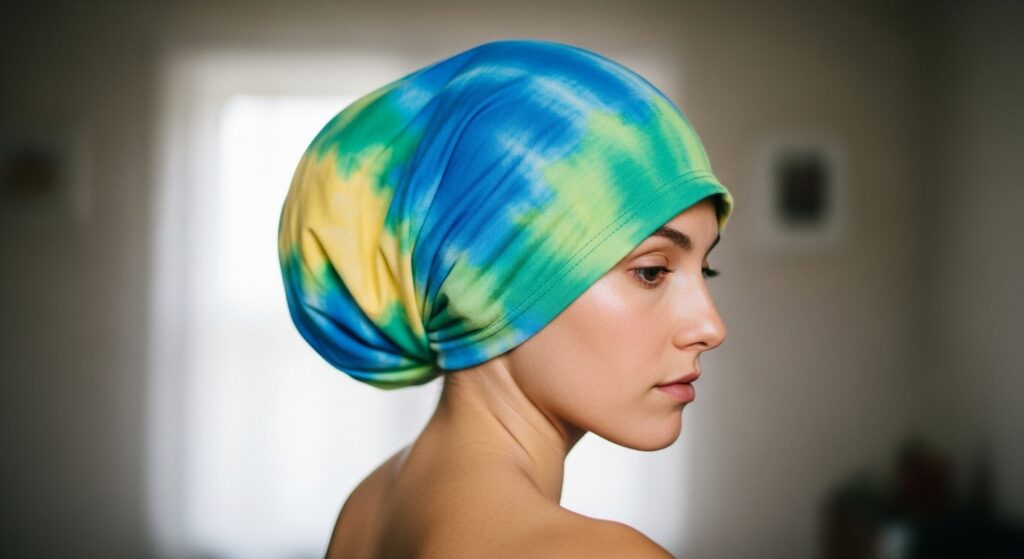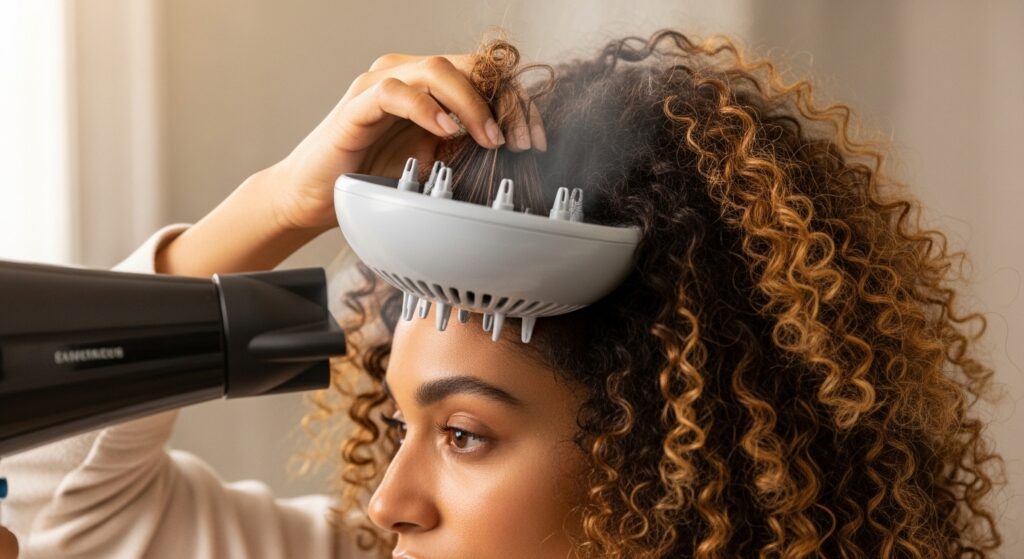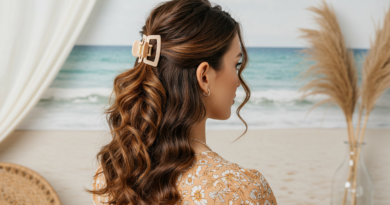How to Get curly hairstyle Hair That Looks Effortless (But Isn’t)
You know the look. It’s that perfect head of curly hair that seems to defy gravity and logic. It’s bouncy, defined, and full of life, yet it looks like it was simply tousled by a gentle breeze and left to dry naturally. No fuss, no crunch, just pure, effortless beauty. What if we told you that this “effortless” look is often the result of anything but? The truth is, achieving curly hairstyle hair that looks carefree requires a bit of care and a whole lot of know-how.
This isn’t about fighting your natural texture or forcing it into submission. It’s about working with your curls to enhance their natural pattern, boost their health, and create a style that looks like you didn’t try at all. Get ready to demystify the process. We’re diving deep into the art and science of creating stunning, “effortless” curls that will have everyone asking for your secret.

1. The Foundation: It All Starts in the Shower
You cannot build a masterpiece on a shaky foundation, and the same goes for your curls. The journey to effortless-looking hair begins with your wash routine. This is where you set the stage for hydration, definition, and volume.
Embrace the Co-Wash and Clarify: Not every wash day requires a harsh shampoo. For many curlies, frequent shampooing can strip natural oils, leading to dryness and frizz. Enter the conditioner wash, or “co-wash.” Using a gentle, cleansing conditioner helps to refresh your curls without completely drying them out. However, product buildup is the enemy of bounce, so it’s crucial to use a clarifying shampoo once every 2-4 weeks to reset your scalp and hair, removing any lingering residue that weighs curls down.
Hydration is Non-Negotiable: Curls crave moisture. When shopping for shampoo and conditioner, look for formulas rich in hydrating ingredients like shea butter, coconut oil, aloe vera, and glycerin. While you’re in the shower, don’t be shy with your conditioner. Use a wide-tooth comb to detangle your hair while the conditioner is in, working from the ends up to the roots. This minimizes breakage and ensures the hydrating product is evenly distributed from root to tip.

2. The Technique: Mastering the Application
What you put in your hair is important, but how you put it in is often the game-changer. The right application techniques can mean the difference between a frizzy mess and defined, soft curls.
The Power of Praying Hands and Scrunching: After you’ve rinsed out your conditioner, it’s time for your styling products (leave-in conditioner, curl cream, gel). A key technique for reducing frizz is the “praying hands” method. Smooth your product over sections of your hair by gliding it between your palms, as if you were praying. This helps to coat the hair shaft evenly and smooth the cuticle. Follow this up with the classic “scrunch.” With your head tilted to the side, gently scrunch your hair upwards towards your scalp. This motion encourages your natural curl pattern to form and adds crucial volume.
Plopping for Perfect Definition: If you haven’t tried plopping, you’re missing out. This technique uses a cotton t-shirt or a microfiber towel to dry your hair in a way that enhances curl formation and minimizes disturbance. Lay the t-shirt flat, flip your head over, and place your hair in the center. Then, fold the bottom of the shirt up, followed by the sides, and tie it all at the nape of your neck. Leave it on for 15-30 minutes. This allows your curls to set without being roughed up by a traditional towel, which can cause frizz.

3. The Product Cocktail: Your Curly Hair Arsenal
Creating an effortless curly hairstyle is like mixing the perfect cocktail—you need the right ingredients in the right proportions. Understanding the role of each product will help you build a routine that works for you.
Leave-In Conditioner: This is your baseline hydration. Think of it as a lightweight moisturizer for your hair, providing a layer of protection and continuous conditioning throughout the day.
Curl Cream: This is your definition and texture hero. Curl creams help to shape your curls, reduce frizz, and provide a soft, touchable hold. They are perfect for achieving that “I didn’t use any product” look while still offering control.
Gel: The Secret to Lasting Hold: This is where the “effortless but isn’t” magic happens. A good, hard-hold gel is your best friend. It might feel counterintuitive—won’t gel make my hair crunchy? Yes, initially. But this is the secret. Apply a generous amount of gel after your cream (this is called the “styling sandwich”). Once your hair is completely dry, you will “scrunch out the crunch.” Gently scrunch your hair until the hard cast breaks and you’re left with soft, defined, and incredibly long-lasting curls that are immune to humidity and touch.

4. The Drying Process: Patience is a Virtue
How you dry your hair can make or break your curl pattern. Rushing this step is a one-way ticket to Frizzville.
Air Drying vs. Diffusing: Air drying is the most gentle method and can yield beautiful results, but it can take a long time and sometimes lead to stretched-out curls at the roots. For more volume and faster drying, a diffuser is your best bet. Attach it to your hairdryer and use it on a low heat and low speed setting. Don’t just toss your hair around in the bowl! Place sections of your hair into the diffuser, bring it up to your scalp, and hold it there for a few minutes before moving to the next section. This “hovering” or “pixie” diffusing method encourages root lift and preserves curl definition without causing chaos.
The All-Important Scrunch Out the Crunch: As mentioned, this is the final, transformative step. Once every single strand of your hair is 100% dry and has formed a hard cast from the gel, it’s time. Take a small amount of hair oil or serum on your palms, rub them together, and then gently scrunch your hair. You will hear a slight crunching sound—that’s the cast breaking. Keep scrunching until all the hardness is gone and your hair feels soft and movable. The result? Defined, bouncy, non-sticky curls that have incredible hold.

5. The Maintenance: Keeping the Magic Alive Overnight and Beyond
You’ve achieved the perfect curly hairstyle. How do you make it last for more than one day? With a little strategic maintenance, your day-two and day-three hair can be just as good, if not better.
Protect Your Curls While You Sleep: Cotton pillowcases create friction that roughs up the hair cuticle, leading to frizz. Switch to a satin or silk pillowcase, or better yet, protect your hair directly with a satin or silk bonnet or scarf. If that’s not your style, try a loose “pineapple” ponytail. Gather your hair at the very top of your head with a soft, coiled hair tie (never a regular elastic) to prevent flattening.
The Art of the Refresh: Don’t assume you need to fully wet your hair every morning. Often, a simple refresh is all you need. Mix a little water and leave-in conditioner in a spray bottle. Lightly mist your hair until it’s damp (not soaking). Then, gently rescrunch your curls. You can also use a tiny bit of cream or gel emulsified with water in your palms to smooth over any particularly frizzy sections. This re-activates the product from the previous day and brings your curls back to life.

Embrace the “Effort” for Truly Effortless Curls
So, there you have it. The secret to that coveted, effortless curly hairstyle isn’t a lack of effort, but rather a series of intentional, well-executed steps. It’s about understanding what your unique curls need—from the right hydrating products to the gentle techniques that define rather than destroy. It’s about embracing the “scrunch out the crunch” and protecting your hard work overnight.
The journey to great curl days is one of experimentation and patience. What works for one head of curls might not work for another. The true key is to listen to your hair, celebrate its unique pattern, and enjoy the process of enhancing its natural beauty. Now go forth, armed with these secrets, and create your own perfectly imperfect, “effortless” curly masterpiece.



